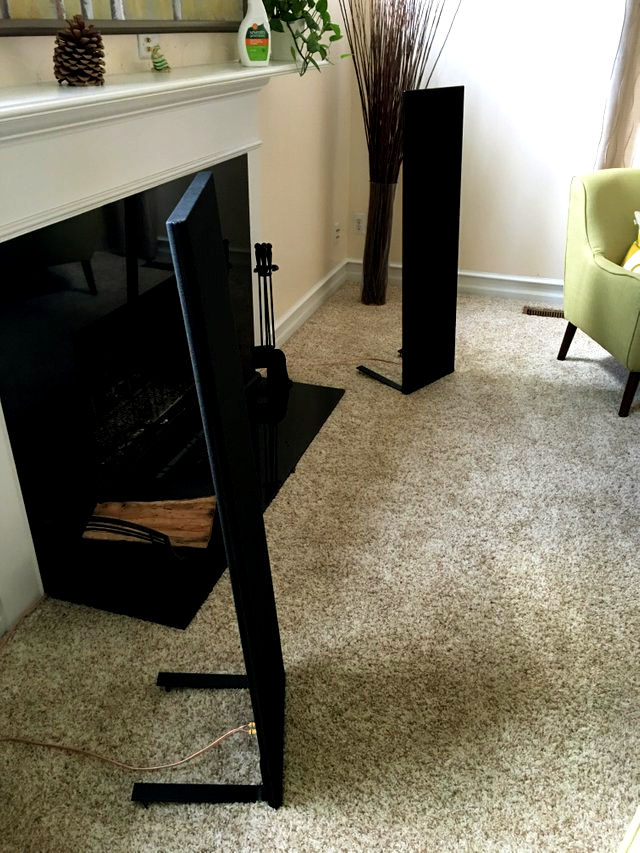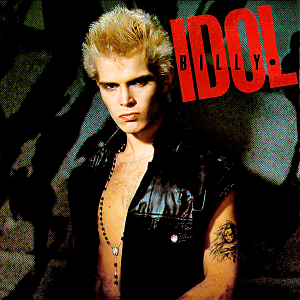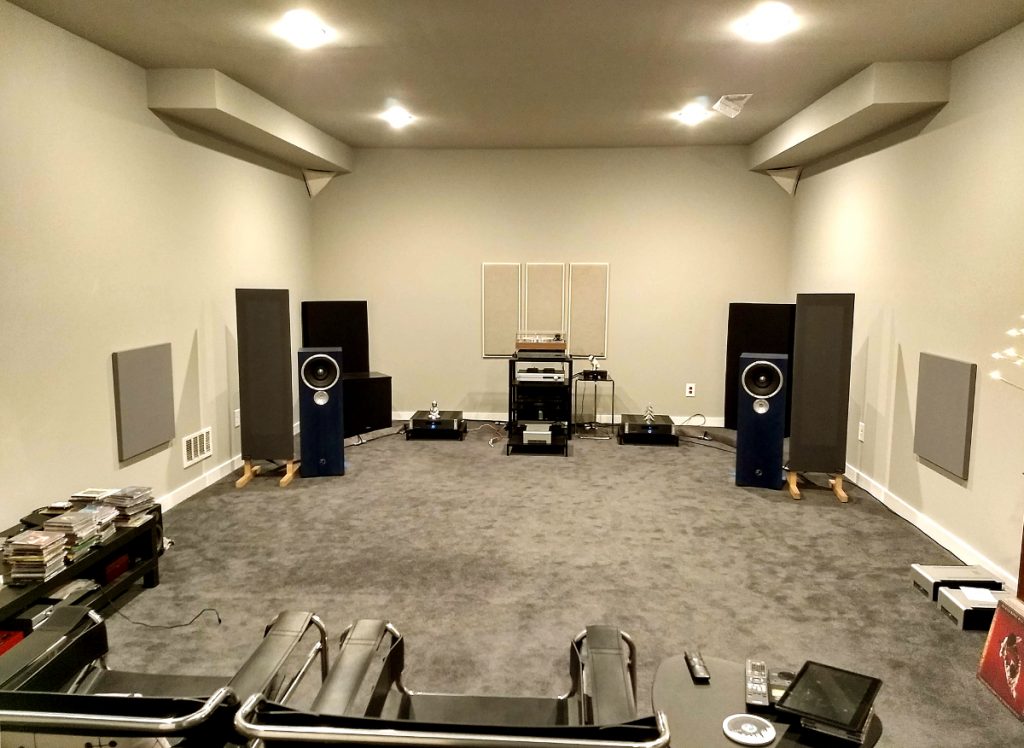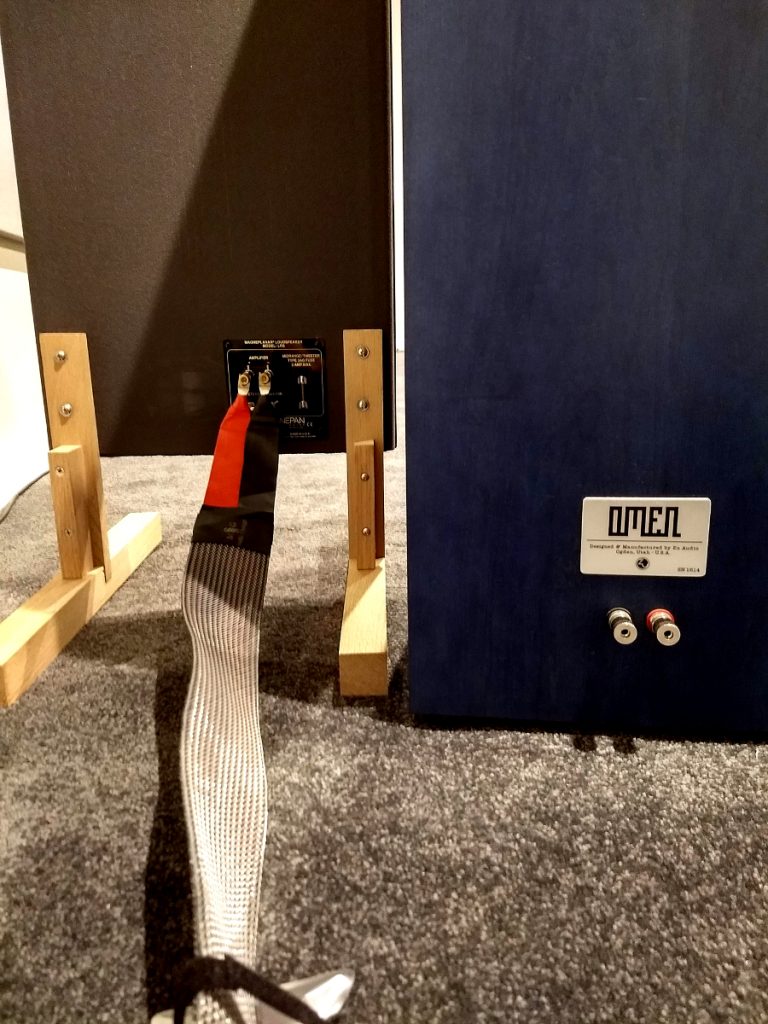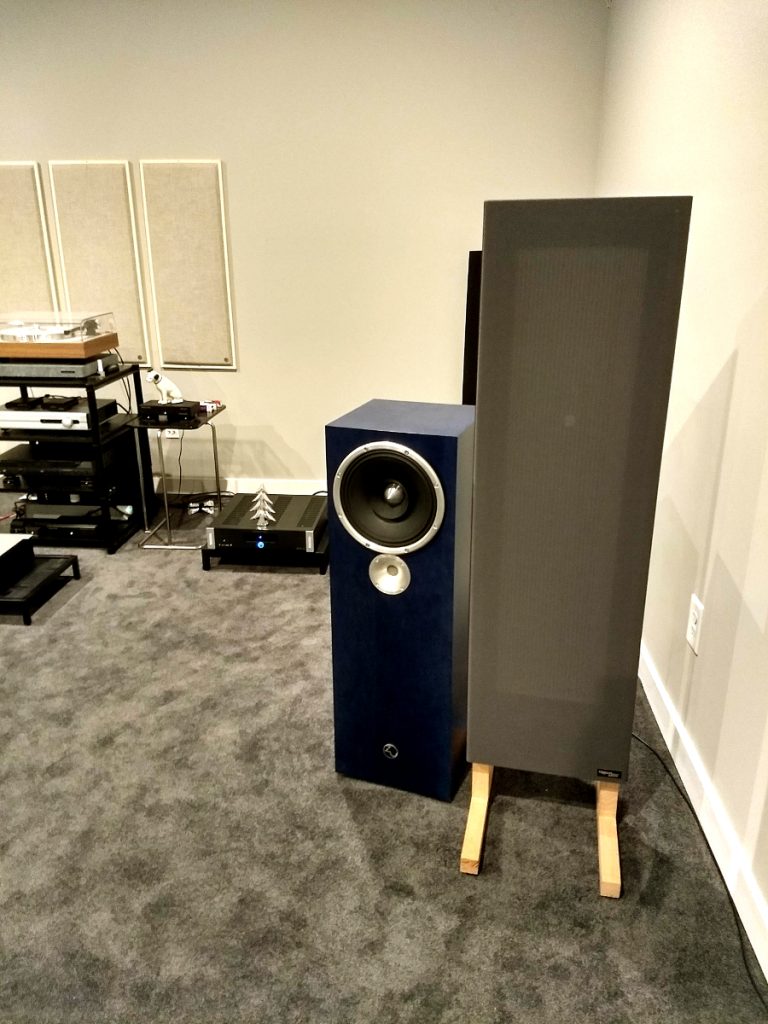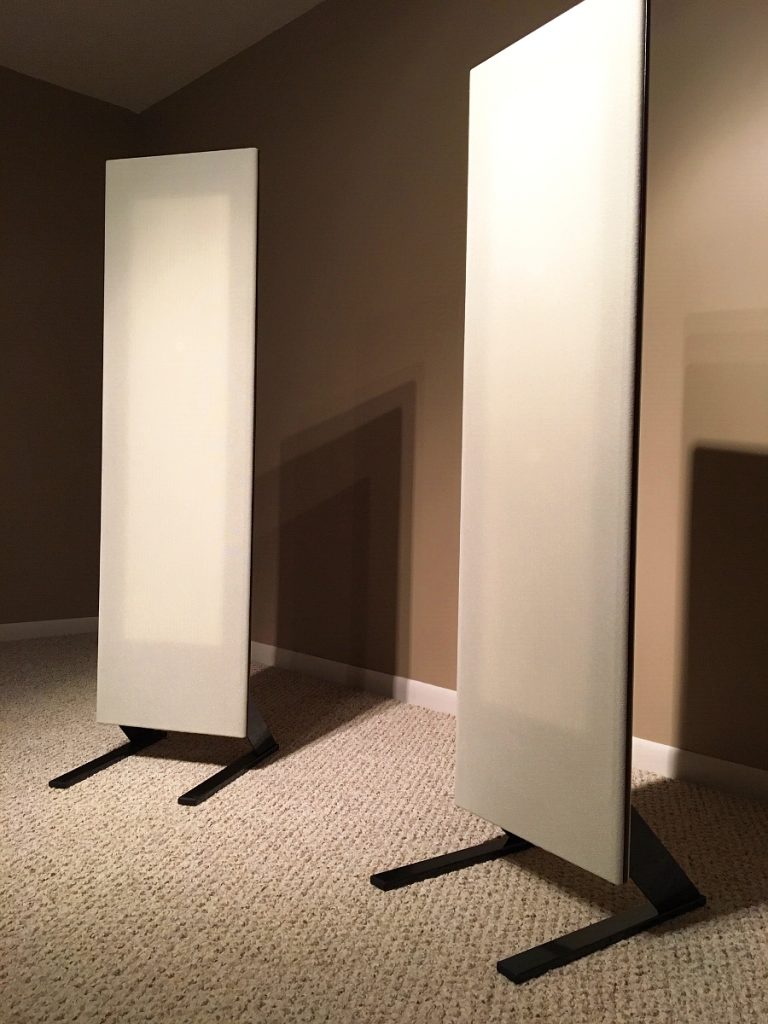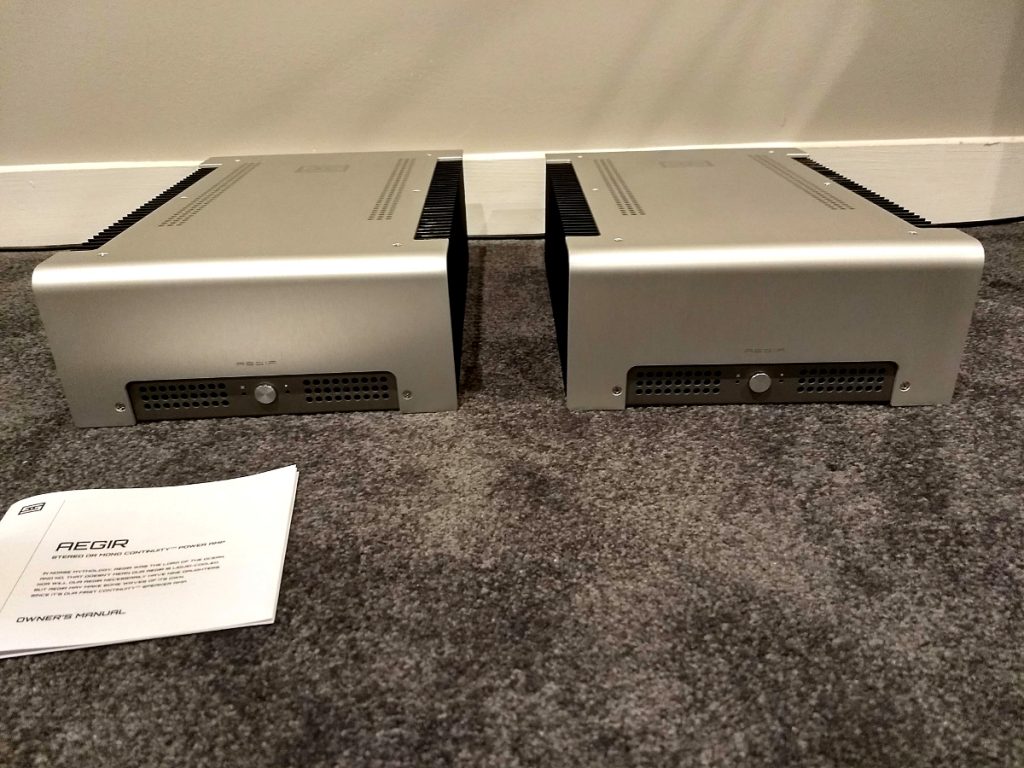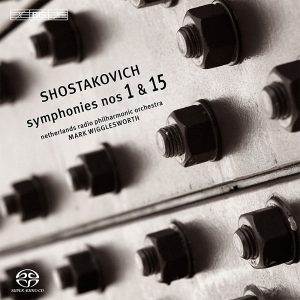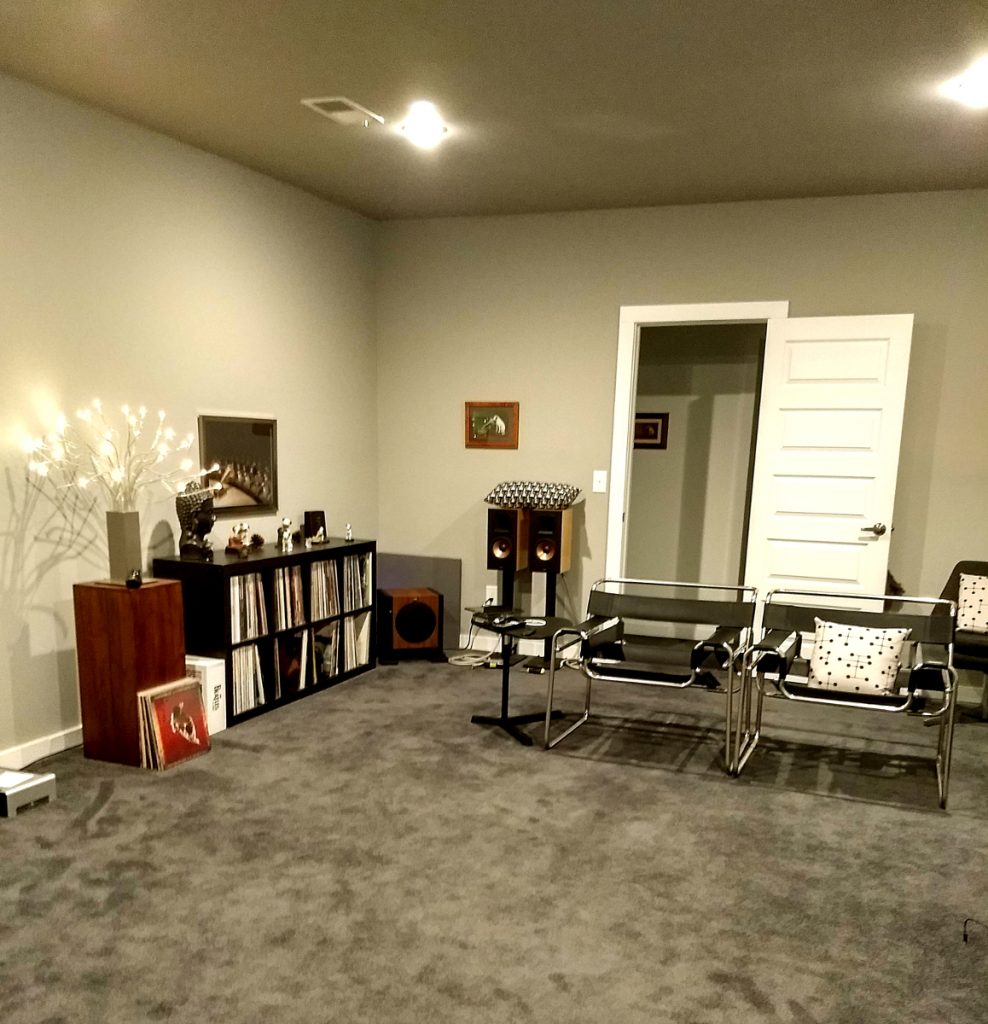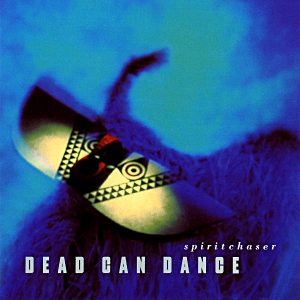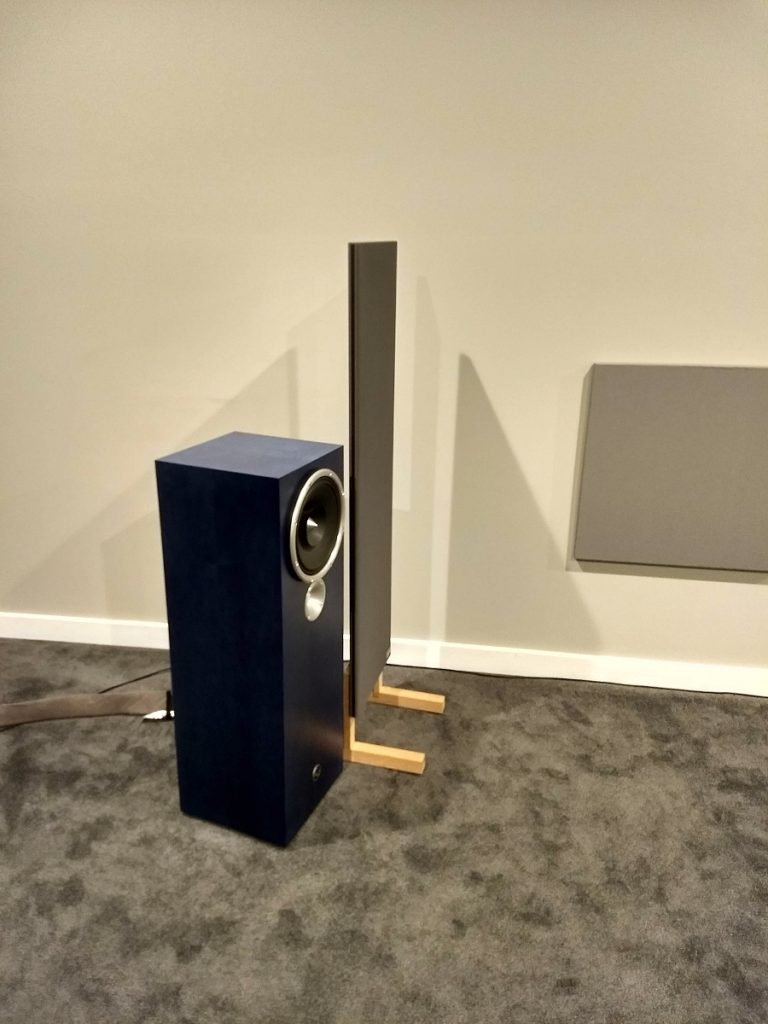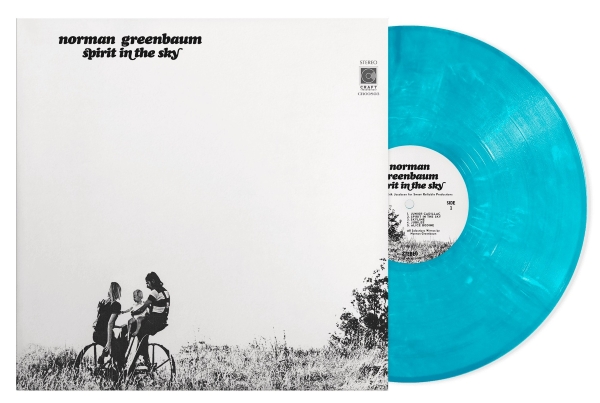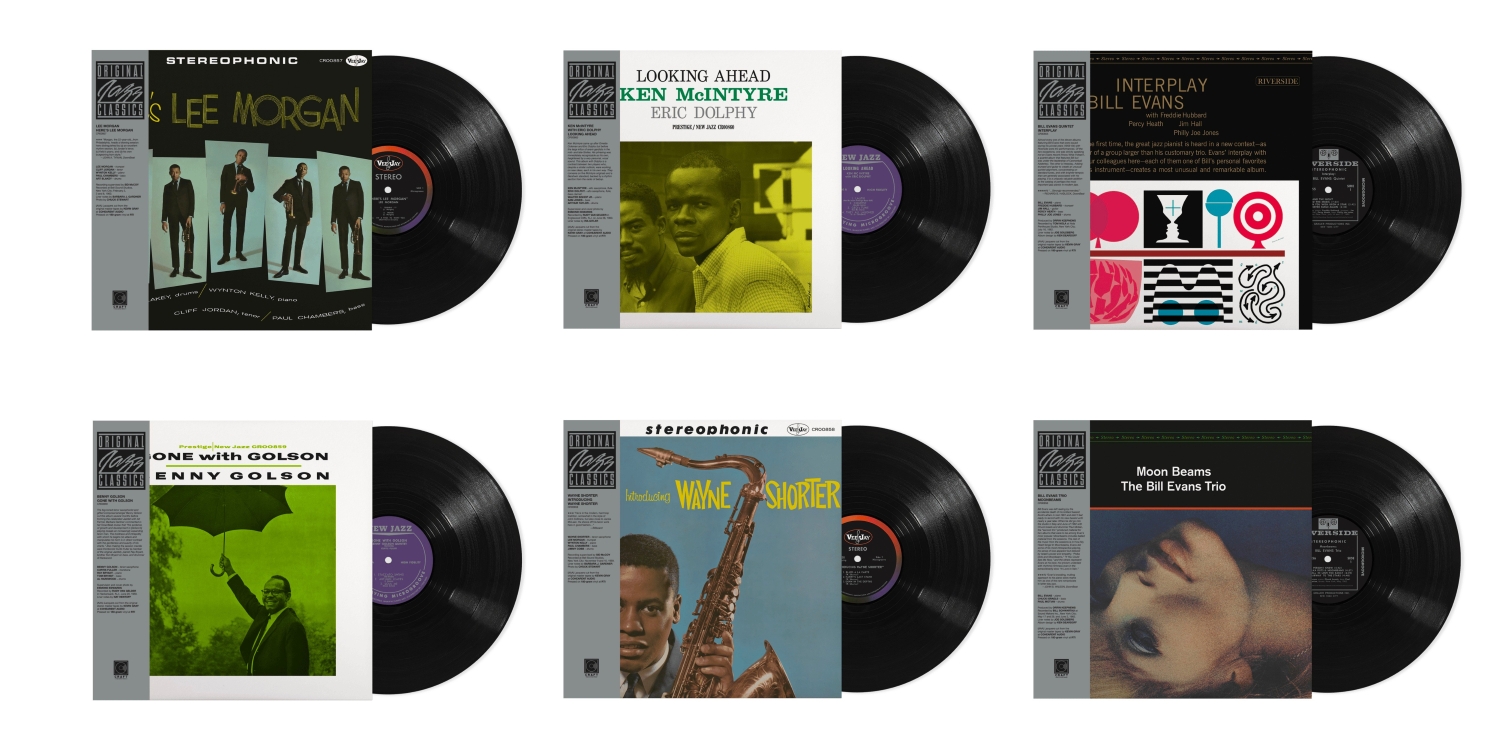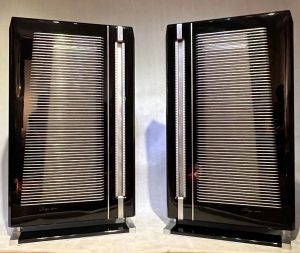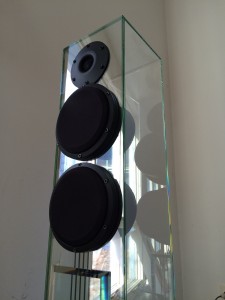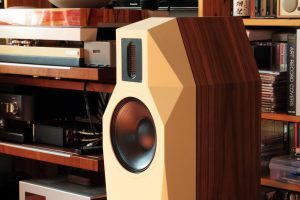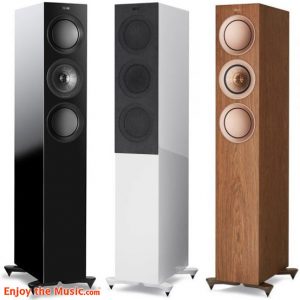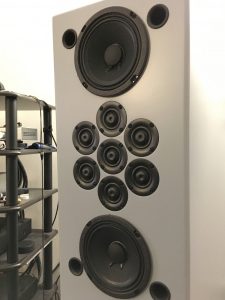The Magneplanar LRS with stock stands attached
1973: William Michael Albert Broad sat at his desk at the Worthing High School for Boys with a particularly nasty scowl on his face. He'd just been handed his report card for the term, on which his chemistry teacher had scrawled the word "idle" across the unusually low marks for that semester. "Idle," he thought to himself; the intent of his teacher was to impress upon his parents young William's complete lack of interest in the periodic table of elements. William knew that feeling intimately, he bloody well hated chemistry. "Idle"….he'd show them idle; he'd give them an idol that they'd all bow down to! Pretty soon, "Billy" as he was called by his circle of friends, became known around the UK and the world as Billy Idol. And with some help from the fledgling MTV, his record sales began a headstrong platinum push onto the worldwide charts.
Flash forward to the early eighties; I was still pretty much a directionless twenty-year-old who'd just gone through a period of extreme withdrawal from society. I'd just been jilted by the girl I thought was the love of my life—pretty harrowing stuff for a twenty-something. As part of my complete knee-jerk reaction to the series of events, I sold my car, my stereo equipment, most all my records, and bought a bicycle and decided to "get back to nature." Besides, the commies were going to push the red button down any day, and I desperately wanted to feel the earth beneath my feet before the planet was vaporized in a fireball of flames. That lasted all of two years; I snapped out of it when another woman (who eventually became my wife) started paying attention to me. Before long, I'd bought a new car and was on a serious hunt for new a new stereo rig, as well.
I'd just started noticing magazines like Stereophile and TAS on the newsstands, and eventually started seeing ads for this loudspeaker brand called Magneplanar. I was definitely intrigued by their appearance, which was unlike anything I'd ever seen before. Magneplanars soon became lodged in my brain...
A little background is in order....
My first ever pair of loudspeakers were purchased from a local Atlanta place called Stereo Village; they were one of the big-box Sansui models, with sculpted walnut grilles, a sixteen-inch woofer, and about a half-dozen drivers. The real-wood cabinets and those beautiful grilles were the real selling point. I didn't even ask to listen to them—they were so freaking beautiful; and with so many drivers, how could they not sound exceptional? The harsh truth was, they sounded really horrible, with non-existent bass and anemic treble; they were easily the worst sounding loudspeakers I've ever owned. I wish I still had them, simply for posterity—I still love the look, and would love to rework a pair to try and improve upon their sound. Anyway, I had to get rid of them ASAP, and the next thing that caught my eye was a brand I'd never heard of, with a most unconventional driver: a pair of ESS loudspeakers, with the Heil Air Motion Transformer tweeter. This time, I listened, and was blown away by the crispness and clarity the Heil AMT imparted to the sound. I instantly pulled the trigger, and was in love for some time. When my period of depression hit me like a ton of bricks, I sold them, along with everything else. Christ almighty, I wish I still had those, too! The couple of years I went without a stereo gave me pause for reflection on a great number of things, including my future direction with my stereo obsession.
It was now 1982; and as things were beginning to move along with my new girlfriend, Beth, they were also beginning to move in my quest for a new rig. We must have traveled to listen to a dozen different pairs of loudspeakers over a period of six months or so. It was a new experience for her, but she seemed to tolerate it with a surprising level of patience. The Magneplanars were still tucked away in the back of my brain; eventually, I found out that a dealer in Atlanta, Fat Julian's Audio, carried the Magneplanar line. I told Beth about it, and that weekend we trekked down to Fat Julian's to have a listen!
We arrived at Fat Julian's on a Saturday morning; Julian was there, and he was indeed rather rotund. However, he was busy with another customer, but he managed to rouse a particularly disinterested-looking, long-haired character behind the front counter, who grudgingly agreed to assist us. The model we were looking at was the MG-I IMP, Magneplanar's (at the time) baseline model, which sold for about $750 in 1982. After taking us to a listening room, he at least asked if there was anything in particular we'd like to listen to. Being so instantly starstruck by actually being in the same room as the object of my upcoming obsession, I told him no, just pick something. Beth and I sat on a sofa in the demo room as he cued an LP.
He dimmed the lights, and suddenly searing across the near-holographic soundstage of the Maggies was Steve Stevens' trademark guitar intro, with none other than Billy Idol belting out his then hit, "White Wedding." Although it wasn't the version I'd seen on MTV—the record was an extended play single, with both parts of "White Wedding" on a single side, which I'd never heard before. As the music pounded my brain for seven-plus glorious minutes of completely chaotic madness, I knew the quest had come to an end—this was indeed the grail. When we left, I knew the task at hand—how was I going to raise $750? I'd only spent about $350 on the ESS speakers, and was still living at home at the time of their purchase; I now had rent and utilities to pay, and anything approaching a grand seemed like very large cash to me! Over the remainder of the weekend, I came up with a plan; I told Beth I was taking out a part-time job to raise the money.
She was obviously skeptical, but I went to work at the local K-mart, working about twenty hours a week evenings for six months or so, and eventually saved up the dough. At that point, we were both working for a large local commercial printer; I was on midnights, and she worked the 3-11 afternoon shift. We only saw each other on weekends, so it didn't really matter that I was working four hours every night at K-mart, then going directly to the printing plant for the rest of the night. We'd moved in together by then, and she'd bought a new Datsun Pulsar NX Turbo—which was a really fun little car, very quick out of the gate—that also had fold-down rear seats. Great—that would be perfect for getting the Maggies home in! I got off work on the Saturday morning of the purchase, drove over to our apartment, took her keys (she was still sleeping) and left mine there, and headed south to Fat Julian's. This was going to be the best day of my life!
I drove the hour-plus to Atlanta, picked up the Maggies, drove the hour-plus back; Beth was waiting on me with absolute fury in her eyes. How dare I take her new car, especially without her permission—was I insane? Maybe; but wait 'till you see what I've got in the back of the car! "What could possibly be in the back of the car that would make any difference?" was her retort. I popped the hatchback to reveal the Magneplanar box; at that point, she literally screamed at me: "You actually worked all those hours to buy those stupid speakers? I thought you were going to buy me an engagement ring with the money!" At that point, thirty-six years ago, she completely grasped my mania and (misplaced?) priorities in life; to say that I've been astonished that she's hung with me all these years is a complete understatement. I've never lived that day down; she reminds me of it at least on an annual basis, and we've been through five pairs of Magneplanars since. It's been a definite love-hate relationship, but I've always had a pair of Magneplanars somewhere in the house since forever.
The Magneplanar Little Ribbon Speaker (LRS)
I first heard about the LRS while this year's AXPONA show was going on in Chicago; there were live reports on Facebook that Magnepan had a "secret" room where they were stealthily displaying their new small speaker for select attendees. I wasn't in attendance, but, hmmmm….my fifteen-year-old pair of heavily modded MMGs were getting rather long in the tooth, and they had suffered from some delamination issues at the point when I originally got them. And despite my efforts at repairs and ongoing maintenance, perhaps it might be time to retire them, and take a listen to Magnepan's latest offering! I contacted Wendell Diller of Magnepan post-haste, and after a wait of five months (these are very popular speakers!) they finally arrived. And the word from Wendell was: the new LRSs are not just an introduction to the current state of Magneplanar sound. They're fully ready for prime time, and perfect for use with even the most challenging state-of-the-art amplifier configurations.
The fit and finish of the Magneplanars has changed a bit since my last pair; the wood side rails are now internal to their construction, rather than attached outwardly to the sides as in the past. It makes for a very streamlined, modern appearance, which fits in really well with my new mid-century modern home's aesthetic. Aside from their outward appearance, very little has changed over the years in terms of their functional setup and the appearance of fittings, connections, stands, et al—over the last twenty years or so. Setup was very straightforward—stands on, speakers up—and I have years of experience with their in-room positioning, toe-in, etc. I prefer more of a widely-placed stance, with minimal toe-in—in my experience, it offers a better stereo image, and the Maggies tend to just disappear from the soundstage.
However...I ran into a bit of a snag right out of the gate with the speaker cable connections, which are a bit unconventional, to say the least. Remember that I'd heavily modified my last pair, the MMGs—that process involved the deconstruction and removal of the stock connection plate and the addition of a new outboard crossover arrangement, which I had fitted with conventional binding posts, and, well—it'd been quite a few years since I'd needed to remember the intricacies of connecting speaker cables other than bare wires to the Maggies. The stock connection panel looks essentially the same as it always has, and is more conducive to the use of banana plug connections—but I'd forgotten just exactly how far out one needed to loosen the set screws to get anything into the holes. No matter it seemed how far out I outwardly twisted the set screws, the banana plugs just wouldn't fit! My consternation was about at its limit—when, finally, I reached the point where the banana plug adapters for my MG Audio speaker cables would actually fit in the hole. Jeez, that was a challenge!
Next up, I quickly discovered that I was less than enthusiastic with the supplied stand configuration; I knew this was coming, and went back to the room where my modded MMGs were and robbed them of the custom solid-oak stands I'd built for them about ten years ago. They're not as crude as some I'd seen online, and not particularly elegant, but they help immeasurably in getting: 1) the panels upright, providing a much better soundstage presentation, and, 2) greatly improving the overall bass response of the small Maggies. Which I've always felt is hindered a bit by use of the stock stands. I'm currently in negotiations to have a set of custom metal stands (Magna Risers, talked to him again today, they're on the way!) sent my way, and am certain that they'll improve the situation even more dramatically. Anyway, my custom stands have seriously improved the quantity and quality of Maggie bass by getting the LRS more firmly coupled to the floor. I worked a bit and was able to find a good positioning for the Maggies that didn't interfere with my already determined best placement for my Zu Audio Omens; it works well for both, and makes for easy cable swaps between the two pairs of loudspeakers.
Magna Risers are on the way...
Magneplanar Power Requirements
I mentioned that Wendell had basically been proffering that the LRS are a fully-realized audiophile loudspeaker, ready for use with any audiophile-grade amplifier. And not specifically tuned for use with mid-fi receivers, etc., as the MMGs (Magnepan's previous mail-order only offer) were designed. We'll see how that actually plays out, but first, I need to share a bit about my current system and some observations that I've made over thirty years of Maggie ownership and day-to-day use.
My current system involves the Zu Audio Omens as my day-to-day loudspeakers for about the last four years. They're a box speaker design that employs a full-range 10.5 inch driver that's based on designs from the 1930s; it's complemented by what is essentially a horn driven tweeter, and there's no crossover, so the sound is pretty seamless and ungimmicked. I'm driving them with a pair of Emotiva XPA 1L monoblocks, which run 35 continuous watts of pure Class A; however, it's a sliding-bias configuration, that allows for up to 250-watts of Class A/B power for peak demands when needed. They're also switch selectable to run in Class A/B only, where they will deliver 500-watts into 4 ohms. Paired with the Zu Omens, the combination has offered nothing less than magnificent sound, the Zus have never been left needing more power, and have powered their way through the most mind-numbing, skull-crushingly demanding musical transients, never once stumbling—I fear more for my home's foundational integrity than the ability of this combo to deliver unbridled sound.
In my early experiences with Magneplanars—and prior to the point where I actually considered myself an audiophile—I was typically running a receiver or integrated amp with them. They were all of Japanese build; Technics, Onkyo, Sony, and the like—I typically only had forty or maybe sixty watts of questionably clean (and probably abysmally low-current) power available to me. I blew tweeter fuses with such regularity, I bought them quite literally by the gross—at some point, I got really tired of running back and forth to Radio Shack. Early on, I never made the connection that the problem I was experiencing was not just that the Maggies regularly blew tweeter fuses when under duress—it was that the mid-fi junk I was trying to drive them with was woefully underpowered.
About the time that I had gotten the older pair of MMG, I had also suffered a lightning strike at my old house, which killed just about everything electronic throughout the house, including most of my stereo setup. Particularly, the made in the USA Acurus 250-watt amp I was using to power them. The only thing at the time I could afford that would offer the same level of available clean power was the Emotiva XPA-2; I took a chance, even though it was Chinese-made, and haven't looked back. I can't say enough good things about the Emotiva amps from that point in time; I'm not as big a fan of their current offerings. When the XPA 1L's came along, I jumped at the chance—they're remarkable amplifiers that continue to amaze me with their goodness.
Emotiva altered their front panel LED configuration with the XPA 1L, so the status lights only indicate when a fault condition exists. So I have to rely upon my ears to tell me if they're being overdriven, and it's never happened in nearly five years. Their older amp models—like my XPA-2—showed if the amp was close to being pushed into clipping (yellow) or actually clipping (red). The XPA-2 was capable of outputting 300-watts into eight ohms, and 490-watts into four ohm loads; the four ohm load is close to what my previous Maggies measured during operation. Frequently while listening with my older pair of MMGs, even at SPLs that didn't seem too out of control, the XPA-2's LEDs would flash yellow and occasionally very briefly red—meaning that during normal operation, they were often absorbing as much as close to 500 watts! And completely in stride, with no audible signs of stress or distortions—and with the tweeter completely bypassed and unprotected. I finally made the connection: Magneplanars (even the little ones!) need watts—preferably a limitless supply of them.
Powering the LRS
At the point when I was waiting for the LRS to show up, I had also been in negotiations with Schiit Audio to receive a pair of their new Aegir amplifiers (Stereophile Class A rated!), which are what Schiit calls a "continuity" design. It's a variation of Class A bias operation that's been tuned to give the amps a sound character much more in common with that found in single-ended triode tube amps. I'd recently reviewed a pair of the ampsandsound Leeloo single-ended triode amps, and can indeed testify that the Aegirs do share a very similar sonic character with the SET Leeloos—spookily similar, in fact! But with about 80 watts @ 8 ohms mono for the Aegirs (Stereo @ 8 Ohms 20W RMS per channel, Stereo @ 4 Ohms 40W RMS per channel, and Mono @ 8 ohms 80W RMS), compared with about 3-watts for the Leeloos. The pair of Aegirs showed up about a week after the LRS; I set them up on a Saturday evening, with the intent of having a listen on Sunday after they'd had about 12 hours to sufficiently warm up. Much of my listening would consist of selections taken from my music server, played through Roon and my Sonore ultraRendu streamer.
So what did I listen to first? Yeah, I know, it should have been "White Wedding," but I decided to ease into the Aegir / LRS combo with something a bit more pastoral before really shaking it down. I chose Debussy's "Claire de Lune" from Khatia Buniatishvili's excellent Motherland, which is a remarkably good album of piano miniatures that have helped to shape her artistic frame of reference. The grand piano sound was astonishingly good, with plenty of sparkle in the upper registers; quite possibly among the best recorded solo piano sound I've experienced in my listening room. At this point, the Aegir / LRS combo seemed a match made in heaven, boding very well for future listening! Remaining in the Classical vein, I continued with another album I've been playing nearly to death recently, the excellent BIS recording of Shostakovich's Symphony No. 1, conducted by Mark Wigglesworth and the Netherlands Radio Philharmonic Orchestra. The second movement "Allegro moto pepetuo" is a thrilling roller-coaster ride of challenging transients and powerful and dynamic percussive effects that will challenge any system. And the Aegir / LRS combo delivered it with the kind of you-are-there realism that had me hitting the repeat button repeatedly—I was stunned by how the LRS were able to handle the dynamics with zero signs of stress! And that glorious sound! Obviously, I had just stumbled onto the closest I'd ever come to audio nirvana!
Just for complete disclosure, I'm running the LRS with a pair of subwoofers—a Def Tech and a small REL—but they're being run full-range, with no crossover involved. That's still quite an impressive achievement for the LRS to have the ability to handle that level of dynamics without cracking a sweat (or even snapping a mid-bass panel!) And the REL sub, well, I've never heard it take on such a bracingly dynamic and powerful character as when paired with the LRS—it was revelatory, to say the least.
Something else I need to point out—that struck me as a bit odd, but not terribly so, especially in light of my recent experience with the SET tube Leeloos. With the Leeloos, I really had to crank the volume knob on my PS Audio preamp, because, well—they only output three watts per channel! The PS Audio unit displays volume from zero to 100, and while that doesn't really correspond with anything meaningful, my typical loud listening (85-90 dBs) with the Zu Audio Omens was at a level of about 40-50 on the scale. With the Leeloos, that often approached 95 to 100 on the scale—with zero added noise from the PS Audio pre. I noticed with the Aegirs it was necessary to crank the volume to somewhere around 75-85 to get acceptably realistic SPLs from the LRS. And everything seemed totally copacetic with nothing but perfect sound from the LRS.
Until I played the next selection—and this is still within the first forty-five minutes of playback with the Aegir / LRS combo. That selection, from the outstanding Vaughan Williams symphony cycle by the late Sir Richar Hickox on the Chandos label, the Symphony No. 2 (London), second movement "Lento." It builds from an almost indiscernible quiet to a series of rolling climaxes that were presented with stunningly dynamic and accurate realism from the LRS. Up to the final forte passage, where I was suddenly shaken from my blissful state by something being not quite right—a blown fuse, perhaps? No worries, I still have plenty of those around, so I shut everything off and popped the fuse from the back panel of the left side LRS. Huh; it still looked perfect—I replaced it anyway and powered everything back up. The whole time I was musing about the fact that Magneplanars are such unusual speakers; one channel can go out, and because they cast such a very wide soundstage, you don't immediately notice that only one channel is playing.
I then noticed that the left side Aegir's power LED was flashing non-stop, and it took some effort on my part to get it to eventually power up like normal, where it played perfectly for about five seconds, then went completely stop. Well, crap—this isn't good at all! The word from Schiit was that it had gone into thermal protection; the power hungry LRS is simply too much for the Aegirs.
Truth of the matter is, the stereo version of the Aegir, at only 20-watts is underpowered for use with the LRS, though when both of the Aegirs as monoblocks were in the system, it was probably the most magical 45 minutes of my musical lifetime! I decided to soldier on with the Emotiva XPA 1L, which I ultimately would be doing anyway. If I'm perfectly honest with myself, the XPA 1L are superb amps, if perhaps not quite exactly on the same level of sparkle and transparency as the monoblock Aegirs. The dream of having both Stereophile Class A rated monoblock amps and loudspeakers (Class A—limited low frequency range) in my system at the same time was apparently over for the time being. At least I still have the loudspeakers!
REL sub tucked away in the opposite room corner
I have to tell you, even with the Emotivas, the sound is pretty fabulous. And with the incredibly inefficient LRS, because you have to really push the volume so to get an acceptable level of SPLs, the two subs are supercharged like never before, and they're not being overdriven. Listening to the Dead Can Dance album Spiritchaser, the second track, "Song of the Stars," has such primally recorded, subterraneanly deep bass, that the two subs shake and energize my room in a shockingly good way. And the icing is that the LRS don't show any signs of stress or distortion at all. Wendell and I had a lengthy telephone conversation about exactly what Magnepan had done to make the new LRS more high-end friendly—of course, all proprietary stuff, or at least he wouldn't tell me anything. The bottom line is this: with a great amp, the LRS play with generally unrestricted volume and traverse difficult acoustic passages effortlessly, and in a manner that's miles beyond my old MMG's. The LRS is a new and instant classic, and a $650 classic at that! In the audiophile world, that's about the price of a cup of coffee.
Continued Listening
I got a response from Schiit Audio; they'd been going through a period of continual flux with the fires and all—and understandably so—and they were going to send me a replacement Aegir for the one that had failed, and also a Schiit Vidar. The Vidar is a more traditional Class A/B amplifier with much higher power—close to 200-watts. No, wait, it seems that they are now only sending the Vidar. I had been switching between the XPA 1L and the functioning stereo Aegir for about a week, still reaching about the same conclusions about the Aegir's unsuitability power-wise for use with the LRS, while still marveling at its impressively good sound character with less demanding music selections. And also being amazed by how the XPA 1L never skipped a beat with the LRS; the LRS constantly screamed for more power, and the XPA 1L obliged, providing effortlessly liquid and dynamic sound that was quite nearly intoxicating.
When the Vidar arrived, I popped it into the chain—and mark my word, it's a very good-sounding amp, and totally up to the task of keeping the LRS happy—it's just not the same musically as having the pair of Aegirs in my system. The overall sound character lacks the sweetness and delicacy of the Aegirs. Even so, I continued to play about with the LRS and the Vidar and Emotiva amps, and took the time to listen to a variety of music that included lots of rock, jazz, and vocals. The LRS responded with surprisingly dynamic and satisfying sound, even cranking out "Highway Star" from a 2012 remaster (incredible disc!) of Deep Purple's Machine Head with impressively loud volume. And I had joked online right after the LRS showed up about "not being able to crank the Sabbath with these"—wrong. You can definitely crank the Black Sabbath, just exercise a little caution until you know how they're going to respond to any particular track, and there's really no rhyme or reason. I would have totally thought the bass panels would freak on the Dead Can Dance stuff, but surprisingly, no sweat! And my new favorite opera singer, Olga Peretyatko—whose piercingly high octaves would definitely have blown the fuses of Maggies from the past—well, she belts out the Rossini with aplomb aplenty, and without straining the LRS's tweeter panels one whit.
So how about that Billy Idol track? With both the Vidar and the XPA 1L, the LRS took me back to the very first time there at Fat Julian's, and yes—it still sounds every bit as astonishing as I found it to sound in 1982. The LRS are way more dynamic than I remember the MG-I to be! I can't thank Billy Idol enough for his role in helping to take me down this very rewarding path.
Conclusion
Do the LRS's deserve their Stereophile Class A rating? Yes, and even more, because they're much more than just a "taste of the high end." Are they absolutely perfect? No, because they definitely have a restricted low frequency range, and certain tracks—especially those that contain strong mid-bass passages, like plucked upper-register acoustic bass—may cause the mid-bass panel to snap and misbehave. Not a common occurrence, but I can cite numerous instances of tracks that have given these babies some level of trouble—and they're almost all jazz records. That said, the ability of these loudspeakers to portray a startlingly realistic image of the recorded event is stunningly good—I can't heap on enough superlatives.
Back to the Wigglesworth Shostakovich disc; in the fourth movement "Finale. Allegro molto," where the orchestral crescendos explode across the soundstage with enormously massive transients—you just wouldn't expect an "entry level" pair of flat panel speakers to be able to recreate this music with completely unrestrained dynamics! The orchestral crash is literally like a train wreck taking place right inside the listening room, but the LRS manages to pull it off without strain of any kid. The series of tympani whacks that follow certainly gave me reason to hold the remote closely—just in case—but the LRS even took those completely in stride! The listening experience isn't lacking in any way; even the $700 Schiit Vidar stereo amp was able to provide the necessary voltage to make the performance shockingly believable—not to flog a dead horse, but the LRS ability to transport you to the recording venue is staggeringly good.
Wendell Diller was correct in his assertion that these are fully-realized Magneplanars; that said, correct amplifier matching—and realistic expectations for their intended use—is of utmost importance. If your musical tastes run more towards acoustic or chamber music, and your intent is to treat the LRS as, say, something akin to a pair of Quad ESLs, where the limitations are well documented—lower powered (but high current!) amplifiers may very well do the trick. And the end results will be perfectly thrilling for many. But if you're looking to drive the LRS's to something closer to reference sound levels with rock, jazz, or orchestral music: choose a high-current amp with lots of watts. Let me reiterate: lots of watts!
I'm keeping my pair; the Magneplanar LRS is most definitely a new classic, and reminds me daily why I fell in love with flat panel speakers in the first place. If you're at all interested, order now—they come with the money-back guarantee if you ultimately decide they're not your cup of tea—and the wait time for delivery is still about four or five months. The LRS is on my best-of list for 2019, and is very highly recommended!
LRS (Little Ribbon Speaker)
Retail: $650/pair
Magnepan
All images courtesy of Magnepan, Magna Riser, and the author




